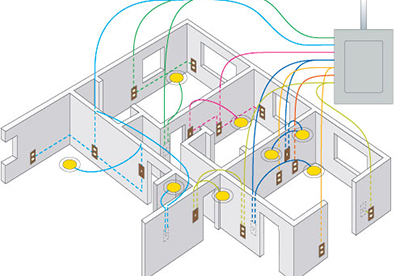Guide to the Canadian Electrical Code, Part I — Instalment 8

December 6, 2015
The CE Code is a comprehensive document. Sometimes it can seem quite daunting to quickly find the information you need. This series of articles provides a guide to help users find their way through this critical document. This is not intended to replace the notes in Appendix B or the explanations of individual requirements contained in the CEC Handbook, but will hopefully provide some help in navigating the code.
Section 14 is a general section of the Code and the Scope applies to all electrical circuits and apparatus installed in accordance with the requirements of the Code unless amended or modified by other sections. As with other sections of the Code, the Appendix B notes contain much valuable information on the use of the rules in Section 14.
Section 14 is divided into three main parts covering general requirements, protective devices, and control devices.
In the General requirements part:
• Rule 14-010 specifies that protective and control devices are required to be provided for electrical apparatus and ungrounded conductors. It provides the most fundamental requirement in the Code: to install control devices in order to manually disconnect all ungrounded conductors of a circuit or to automatically open the circuit if a current in a circuit reaches a value that will produce dangerous temperatures or in the event of a ground fault. The rule is needed to prevent damage or injury due to overloads, short circuits or ground faults, and also hazards caused by a low or no voltage situation. Protective devices include fuses and circuit breakers while control devices include switches as well as circuit breakers.Note that a fuse is not a control device and must be used in conjunction with a switch where control is required.
• Rule 14-012 specifies that protective and control equipment must be selected, in accordance with ratings sufficient for the available fault current and/or for the current level it is required to interrupt, in addition to the voltage involved. This rule is also very important for electrical systems designers and installing contractors, as it mandates that only an O/C device rated for the available fault currentmay be used in an electrical installation.
• Rule 14-014 Series rated combinations provides that adownstream circuit breaker with a lower interrupting rating than the available system fault current level can be used in a series rated combination with a fully rated upstream overcurrent device, such that the upstream breaker opens before the downstream breaker when a high level of fault current is detected. These sub-rules provide the conditions for allowing this arrangement. Note that the downstream breaker is marked with the specific upstream overcurrent device required.
• Rule 14-016 Connection of devices requires thatprotection or control devices shall never be connected in a grounded conductor, with a few exceptions as noted.
The Protective devices part is divided into three divisions: General, Fuses and Circuit breaker.
The General Rules 14-100 to 14-114 cover
• Overcurrent protection of conductors — requires each ungrounded conductor to be protected by an overcurrent device at the point where it receives its supply and at each point where the size is decreased with the exceptions as outlined in paragraphs (a) to (g). It should be noted that exceptions listed in these paragraphs are commonly used by electrical designers and contractor.
• Ground fault protection — this protective feature is additionally required in circuits rated between 150 and 750 volts and more than 1000 amps and circuits rated 150 volts or less and 200amps or more. The sub-rules provide guidance
• Rating of overcurrent devices — generally the rating should not exceed the allowable ampacity of the conductors, which these O/C devices protect. Note: alternatively consult Table 13
• Location and grouping of overcurrent devices — must be accessible and grouped where practicable
• Enclosure of overcurrent devices — accessible operating handles and to authorized personnel
• Grouping of overcurrent devices at a distribution centre— where a panelboard is required
• Overcurrent devices in parallel— restrictions
• The application of supplementary protectors— not to be used for branch circuit protection
The Fuses Rules 14-202 to 14-212 cover
• Time delay and low melting point fuses — “P” and “D” marking
• Use of plug fuses — limited to 125v line to line or 150v to ground
• Non-interchangeable fuses — can’t use a larger rating
• Fuse holders for plug fuses — must be covered type
• Rating of fuses — note some restrictions
• Fuses and fuse holders — only properly rated shall be used
• Use of fuses — selection of fuses by class
The Circuit breakers Rules 14-300 to 14-308 cover
• Circuit breakers general — must be trip-free type and indicate open or closed
• Construction of circuit breakers — must protect all ungrounded conductors in circuit with some noted exceptions
• Non-tamperable circuit breakers — must prevent alteration of current or tripping time
• Tripping elements for circuit breakers — as per table 25
• Battery control power for circuit breakers — battery monitoring, auto trip on low voltage, or alarm and warning sign
The Control devices part is divided into General, Switches, Protection and control of miscellaneous apparatus, and Solid-state devices.
The General Rules 14-400 to 14-416 cover
• Rating of control devices — suitable for loads to be interrupted
• Disconnecting means required for fused circuits — fuses need control devices with some exceptions
• Control devices ahead of overcurrent devices — OC device must be dead when control device is open
• Location of control devices — must be readily accessible
• Indication of control device positions — ON/OFF positions marked
• Enclosure of control devices — must be metal or other fire resisting material
• Grouping of control devices — must be where practicable
• Connection to different circuits — safety rules for equipment with multiple supplies
• Control devices used only for switching — must disconnect all ungrounded conductors in circuit
The Switches Rules 14-500 to 14-514 cover
• Operation of switches — must be operable without exposing live parts in off position
• Mounting of knife switches — so gravity can’t close
• Maximum rating of switches — more than 600A at 750 V used only for isolating
• Connection of switches — moving blades and contacts to be dead when in the open position with some exceptions
• Rating of general-use ac/dc switches — rating for load and use of T rated switches
• Use and rating of manually operated general-use ac switches
• Manually operated general-use 347 V ac switches
• Manually operated switches in circuits exceeding 300 volts-to-ground
The Protection and control of miscellaneous apparatus Rules 14-600 to 14-612 cover
• Protection of receptacles — proper rating
• Additional control devices not necessary — attachment plugs permitted for portable equipment
• Outlet control from more than one point — only switch ungrounded conductors
• Panelboard overcurrent protection — required with noted exceptions also see table 14-1
• Remote control circuits — must be disconnected simultaneously when the circuit they control is off
• Protection of circuits supplying cycling loads — use “P” and “D” type fuses if used
• Transfer equipment for standby power systems — prevent inadvertent interconnection
The Solid-state devices rules 14-700 to 14-704 cover
• Restriction of uses — not to be used as isolating or disconnection means
• Disconnecting means required — to prevent transfer of energy
• Warning notices required
In the next instalment we will outline Section 16 — Class 1 and Class 2 circuits.
Read the rest of the instalments in the series:
Part 1: Guide to the CE Code, Part I – A Roadmap (Installment 1 in a Series)
Part 2: A Road Map to the CE Code, Part I – Installment 2
Part 3: Guide to the Canadian Electrical Code, Part I – Installment 3
Part 4: A Road Map to the CE Code, Part 1 – Installment 4
Part 5: Guide to the Canadian Electrical Code, Part I — Installment 5
Part 6: Guide to the Canadian Electrical Code, Part I — Installment 6
Part 7: Guide to the Canadian Electrical Code, Part I — Installment 7
Part 8: Guide to the Canadian Electrical Code, Part I — Installment 8
Part 9: Guide to the Canadian Electrical Code, Part I — Installment 9
Part 10: Guide to the Canadian Electrical Code, Part 1 – Installment 10
Part 11: Guide to the Canadian Electrical Code, Part 1 – Installment 11
William (Bill) Burr is the former Chair of the Canadian Advisory Council on Electrical Safety (CACES), former Director of Electrical and Elevator Safety for the Province of BC, and former Director of Electrical and Gas Standards Development and former Director of Conformity Assessment at CSA Group. Bill can be reached at Burr and Associates Consulting billburr@gmail.com.

















